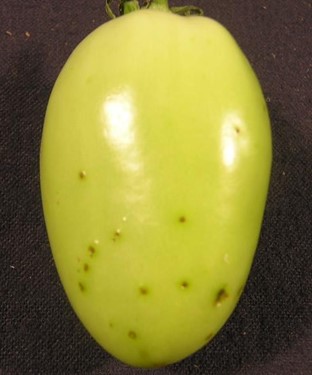Disease Notes
Contact
Plant Diagnostician
Phone: (479) 575-2727
Email: ssmith@uada.edu
Jason Pavel
Diagnostician
Phone: (479) 575-7257
Email: jpavel@uada.edu
University of Arkansas System Division of Agriculture
Cralley Warren Building
Room 16
2601 N. Young Ave.
Fayetteville, AR 72704
Tomato – Bacterial Speck
by Sherrie Smith and Jason Pavel

Tomato Bacterial Speck –Pseudomonas syringae pv. tomato
Photo by Sherrie Smith University of Arkansas Cooperative Extension
What is bacterial speck?
Bacterial speck is generally favored by lower temperatures and wet conditions, and it is caused by Pseudomonas syringae pv. tomato. Leaf spots are dark brown to black, and round. They lack a halo at first but develop one over time. The lesions occur all over the leaf but can be most prominent on leaf tips. All parts of the plant may be affected. On stems, the lesions are oval to elongate. On fruit, tiny dark specks develop. The area around the speck may be greener than the surrounding tissue.

Tomato Bacterial Speck – on leaves
Photo by Sherrie Smith University of Arkansas Cooperative Extension
How can you control tomato bacterial speck?
Control methods consist of planting clean seed, and cultural controls. For bacterial speck, avoid overhead irrigation and working in the garden when foliage is wet. Use clean seed. Clean up crop debris at the end of the season. Practice a three-year rotation where no peppers, tomato, eggplant, or potato are grown in that spot. Practice a preventive copper + mancozeb spray program from bloom until the first-formed fruit are one-third their final size. After that point, the greatest risk of bacterial speck is passed; copper can be dropped from the program.

Tomato Bacterial Speck – on plant stem
Photo by Sherrie Smith University of Arkansas Cooperative Extension
Take Aways
- Avoid overhead irrigation and crowding.
- Practice a three-year crop rotation.
- Clean up all plant debris.
- Practice a spray program from first bloom until first-formed fruit are one-third their final size.
This work is supported by the Crop Protection and Pest Management Program [grant no. 2017-70006- 27279/project accession no. 1013890] from the USDA National Institute of Food and Agriculture.